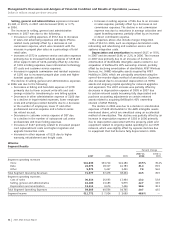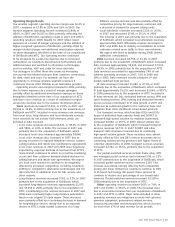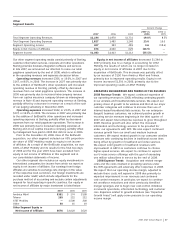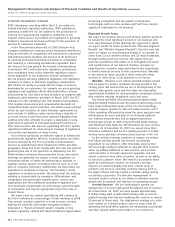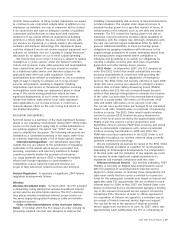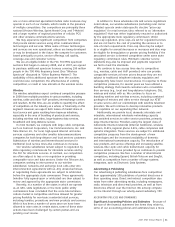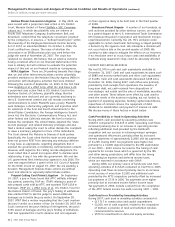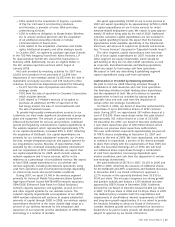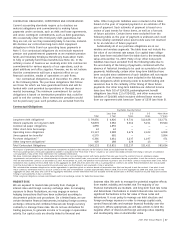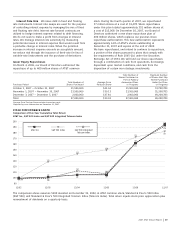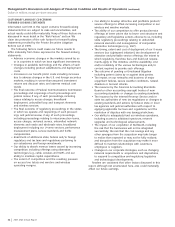AT&T Wireless 2007 Annual Report Download - page 44
Download and view the complete annual report
Please find page 44 of the 2007 AT&T Wireless annual report below. You can navigate through the pages in the report by either clicking on the pages listed below, or by using the keyword search tool below to find specific information within the annual report.
Management’s Discussion and Analysis of Financial Condition and Results of Operations (continued)
Dollars in millions except per share amounts
42
| 2007 AT&T Annual Report
significant impact on our financial statements than others.
The policies below are presented in the order in which the
topics appear in our consolidated statements of income.
Allowance for Uncollectibles We maintain an allowance
for doubtful accounts for estimated losses that result from the
failure of our customers to make required payments. When
determining the allowance, we consider the probability of
recoverability based on past experience, taking into account
current collection trends; as well as general economic factors,
including bankruptcy rates. Credit risks are assessed based on
historical write-offs, net of recoveries, and an analysis of the
aged accounts receivable balances with reserves generally
increasing as the receivable ages. Accounts receivable may
be fully reserved for when specific collection issues are
known to exist, such as pending bankruptcy or catastrophes.
The analysis of receivables is performed monthly and the
bad-debt allowances are adjusted accordingly. A 10% change
in the amounts estimated to be uncollectible would result
in a change in uncollectible expense of approximately $140.
Pension and Postretirement Benefits Our actuarial
estimates of retiree benefit expense and the associated
significant weighted-average assumptions are discussed in
Note 11. One of the most significant of these assumptions is
the return on assets assumption, which was 8.5% for the year
ended December 31, 2007. This assumption will remain
unchanged for 2008. If all other factors were to remain
unchanged, we expect that a 1% decrease in the expected
long-term rate of return would cause 2008 combined
pension and postretirement cost to increase $814 over 2007.
The 10-year return on our pension plan assets was 9.18%
through 2007. Under GAAP, the expected long-term rate of
return is calculated on the market-related value of assets
(MRVA). GAAP requires that actual gains and losses on
pension and postretirement plan assets be recognized in the
MRVA equally over a period of up to five years. We use a
methodology, allowed under GAAP, under which we hold the
MRVA to within 20% of the actual fair value of plan assets,
which can have the effect of accelerating the recognition of
excess actual gains and losses into the MRVA in less than
five years. This methodology did not have a significant
additional effect on our 2007, 2006 or 2005 combined
net pension and postretirement costs. Note 11 also discusses
the effects of certain changes in assumptions related to
medical trend rates on retiree health care costs.
Depreciation Our depreciation of assets, including use of
composite group depreciation and estimates of useful lives, is
described in Notes 1 and 5. We assign useful lives based on
periodic studies of actual asset lives. Changes in those lives
with significant impact on the financial statements must be
disclosed, but no such changes have occurred in the three
years ended December 31, 2007. However, if all other factors
were to remain unchanged, we expect that a one-year
increase in the useful lives of the largest categories of our
plant in service (which accounts for more than three-fourths
of our total plant in service) would result in a decrease of
between approximately $1,810 and $1,860 in our 2008
depreciation expense and that a one-year decrease would
result in an increase of between $2,230 and $2,330 in our
2008 depreciation expense.
Asset Valuations and Impairments We account for
acquisitions using the purchase method as required by
FAS 141. Under FAS 141, we allocate the purchase price to
the assets acquired and liabilities assumed based on their
estimated fair values. The estimated fair values of intangible
assets acquired are based on the expected discounted cash
flows of the identified customer relationships, patents, trade-
names and licenses. In determining the future cash flows we
consider demand, competition and other economic factors.
Customer relationships, which are finite-lived intangible
assets, are primarily amortized using the sum-of-the-months-
digits method of amortization over the period in which those
relationships are expected to contribute to our future cash
flows. The sum-of-the-months-digits method is a process
of allocation, not of valuation, and reflects our belief that
we expect greater revenue generation from these customer
relationships during the earlier years of their lives.
Alternatively, we could have chosen to amortize customer
relationships using the straight-line method, which would
allocate the cost equally over the amortization period.
Amortization of other intangibles, including patents and
amortizable tradenames, is determined using the straight-
line method of amortization over the expected remaining
useful lives. We do not amortize indefinite-lived intangibles,
such as wireless FCC licenses or certain tradenames.
(See Note 6)
Goodwill is not amortized but is tested for impairment in
accordance with Statement of Financial Accounting Standards
No. 142, “Goodwill and Other Intangible Assets” (FAS 142).
We review goodwill, indefinite-lived intangibles and other
long-lived assets for impairment under FAS 142 or Statement
of Financial Accounting Standards No. 144, “Accounting for
the Impairment or Disposal of Long-Lived Assets” either
annually or whenever events or circumstances indicate
that the carrying amount may not be recoverable over
the remaining life of the asset or asset group. In order to
determine that the asset is recoverable, we verify that the
expected future cash flows directly related to that asset
exceed its fair value, which is based on the undiscounted
cash flows. The discounted cash flow calculation uses
various assumptions and estimates regarding future revenue,
expense and cash flows projections over the estimated
remaining useful life of the asset.
Cost investments are evaluated to determine whether
mark-to-market declines are temporary and reflected in other
comprehensive income, or other than temporary and recorded
as an expense in the income statement. This evaluation is
based on the length of time and the severity of decline in
the investment’s value.
Income Taxes Our estimates of income taxes and the
significant items giving rise to the deferred assets and
liabilities are shown in Note 10 and reflect our assessment
of actual future taxes to be paid on items reflected in the
financial statements, giving consideration to both timing and
probability of these estimates. Actual income taxes could
vary from these estimates due to future changes in income
tax law or results from the final review of our tax returns by
federal, state or foreign tax authorities. We have considered
these potential changes and, for years prior to 2007, have
provided amounts within our deferred tax assets and liabilities


